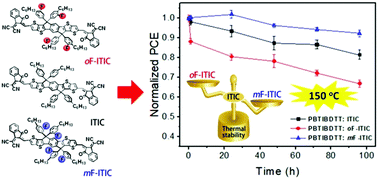Enhancing thermal stability of nonfullerene organic solar cells via fluoro-side-chain engineering†
Abstract
The power conversion efficiencies (PCEs) of nonfullerene organic solar cells (OSCs) have made significant progress. However, little attention has been paid to improving the thermal stability of nonfullerene OSCs, which is critical for future practical application. Herein, two novel isomeric nonfullerene small molecule acceptors (n-SMAs) based on the classical ITIC acceptors, namely oF-ITIC and mF-ITIC, with fluorine atoms substituting at the ortho-alkyl and meta-alkyl positions of the phenyl side chains, respectively, are designed. The effect of fluorinated side-chains on the efficiency and thermal stability is systematically investigated. When combined with PBTIBDTT, both oF-ITIC and mF-ITIC devices show enhanced PCEs as compared to the ITIC device. More importantly, these active layers show distinct degrees of morphological deterioration under thermal annealing. Among the acceptors, mF-ITIC shows the best thermal stability, retaining 92% of its initial device efficiency after thermal annealing for 96 h at 150 °C, while ITIC and oF-ITIC devices only preserve 82% and 67% of their initial efficiencies, respectively. Investigation indicates that the miscibility of donor/acceptor and crystallinity of the acceptors synergistically affect the thermal stability of the active layers, which provides a new molecule design strategy to achieve high efficiency nonfullerene OSCs with outstanding thermal stability.



 Please wait while we load your content...
Please wait while we load your content...